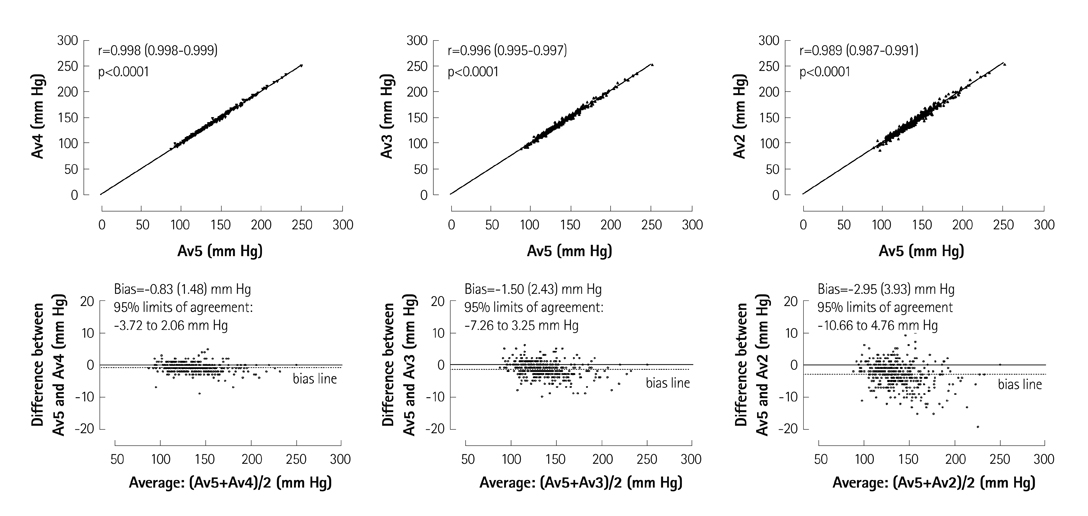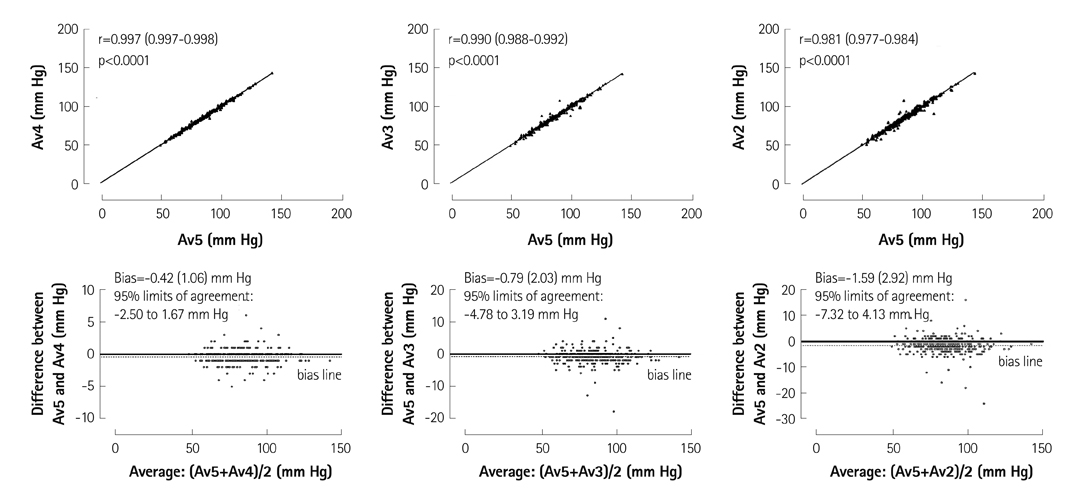Korean Circ J.
2013 May;43(5):329-335. 10.4070/kcj.2013.43.5.329.
Comparison of the Average of Five Readings with Averages from Fewer Readings for Automated Oscillometric Blood Pressure Measurement in an Outpatient Clinic
- Affiliations
-
- 1Department of Family Medicine, Lagos State University Teaching Hospital (LASUTH), Lagos, Nigeria. holladipo@yahoo.com
- KMID: 2224927
- DOI: http://doi.org/10.4070/kcj.2013.43.5.329
Abstract
- BACKGROUND AND OBJECTIVES
The optimal number of consecutive measurements for obtaining an average blood pressure (BP) reading in clinical practice is yet undefined by research. This study aimed to compare readings obtained from an average of 5 with averages of 2, 3, and 4, sequential measurements.
SUBJECTS AND METHODS
Using an automated oscillometric device (BpTRU), BP measurement was conducted on 410 consenting adults attending a general outpatients clinic. Comparison of an average of 5 readings with averages of 2, 3, and 4 readings involved evaluation of correlations, Bland-Altman analysis, comparison of means and distribution of readings, and determination of the proportion of differences between compared readings which were clinically non-significant.
RESULTS
397 (96.8%) sets of complete BP readings were suitable for analysis. Clinically non-significant differences (< or =5 mm Hg) were found between at least 79.3% (n=315) and 96.5% (n=383) of compared systolic and diastolic readings, respectively. Bland-Altman's analysis revealed that the 95% limits of agreement for the differences between compared readings were approximately 2-4, 3-7, and 4-11 mm Hg for 2, 3 and 4 readings' systolic comparisons while those for diastolic comparisons were 2-3, 3-5, and 4-7 mm Hg, respectively. Statistically non-significant differences were observed in all comparisons of the distributions of readings that were classified as <140 mm Hg or > or =140 mm Hg and <90 mm Hg or > or =90 mm Hg for systolic and diastolic readings, respectively. Strong positive correlations were found between 5 average readings and each of 2, 3, and 4 average readings, respectively.
CONCLUSION
An average of 5 readings may be excessive for routine BP measurement using this device at outpatient clinics.
Figure
Reference
-
1. Ghuman N, Campbell P, White WB. Role of ambulatory and home blood pressure recording in clinical practice. Curr Cardiol Rep. 2009; 11:414–421.2. Kim SG. Clinical implications of ambulatory and home blood pressure monitoring. Korean Circ J. 2010; 40:423–431.3. Williams B, Poulter NR, Brown MJ, et al. Guidelines for management of hypertension: report of the fourth working party of the British Hypertension Society, 2004-BHS IV. J Hum Hypertens. 2004; 18:139–185.4. Pickering TG, Hall JE, Appel LJ, et al. Recommendations for blood pressure measurement in humans and experimental animals: part 1: blood pressure measurement in humans: a statement for professionals from the Subcommittee of Professional and Public Education of the American Heart Association Council on High Blood Pressure Research. Circulation. 2005; 111:697–716.5. Mancia G, De Backer G, Dominiczak A, et al. 2007 Guidelines for the Management of Arterial Hypertension: The Task Force for the Management of Arterial Hypertension of the European Society of Hypertension (ESH) and of the European Society of Cardiology (ESC). J Hypertens. 2007; 25:1105–1187.6. Myers MG, Valdivieso M, Kiss A. Optimum frequency of office blood pressure measurement using an automated sphygmomanometer. Blood Press Monit. 2008; 13:333–338.7. Wright JM, Mattu GS, Perry TL Jr, et al. Validation of a new algorithm for the BPM-100 electronic oscillometric office blood pressure monitor. Blood Press Monit. 2001; 6:161–165.8. O'Brien E, Petrie J, Littler W, et al. The British Hypertension Society protocol for the evaluation of blood pressure measuring devices. J Hypertens. 1993; 11:S43–S63.9. O'Brien E, Pickering T, Asmar R, et al. Working Group on Blood Pressure Monitoring of the European Society of Hypertension International Protocol for validation of blood pressure measuring devices in adults. Blood Press Monit. 2002; 7:3–17.10. Crippa G, Ragni G, Venturi C, Arrigoni E, Pancotti D. Repeated office blood pressure (ROBP) measurement for the evaluation of antihypertensive treatment efficacy. Am J Hypertens. 2005; 18(S4):28A–29A.11. Crippa G, Sverzellati E, Venturi C, Antoniotti P. Repeated office blood pressure measurement by automated device to evaluate blood pressure control. Am J Hypertens. 2003; 16(S1):46A.12. Verdecchia P, Angeli F, Borgioni C, Gattobigio R, Reboldi G. Ambulatory blood pressure and cardiovascular outcome in relation to perceived sleep deprivation. Hypertension. 2007; 49:777–783.13. van der Wel MC, Buunk IE, van Weel C, Thien TA, Bakx JC. A novel approach to office blood pressure measurement: 30-minute office blood pressure vs daytime ambulatory blood pressure. Ann Fam Med. 2011; 9:128–135.14. Scherpbier-de Haan N, van der Wel M, Schoenmakers G, et al. Thirty-minute compared to standardised office blood pressure measurement in general practice. Br J Gen Pract. 2011; 61:e590–e597.15. Myers MG, Valdivieso MA. Use of an automated blood pressure recording device, the BpTRU, to reduce the "white coat effect" in routine practice. Am J Hypertens. 2003; 16:494–497.16. Culleton BF, McKay DW, Campbell NR. Performance of the automated BpTRU measurement device in the assessment of white-coat hypertension and white-coat effect. Blood Press Monit. 2006; 11:37–42.17. Powers BJ, Olsen MK, Smith VA, Woolson RF, Bosworth HB, Oddone EZ. Measuring blood pressure for decision making and quality reporting: where and how many measures? Ann Intern Med. 2011; 154:781–788. W289–W290.
- Full Text Links
- Actions
-
Cited
- CITED
-
- Close
- Share
- Similar articles
-
- Automated Office Blood Pressure Measurement
- Evaluation of the DINAMAP 8100 Automated Blood Pressure monitor: comparison with the Mercury Sphygmomanometer
- A Representative Value for 24-hr Ambulatory Blood pressure Monitoring
- A representative value for 24-hour monitored ambulatory blood pressure
- Oscillometric Blood Pressure Values of Infants and Children



